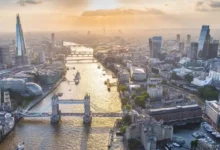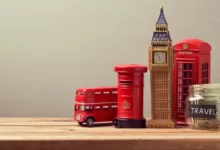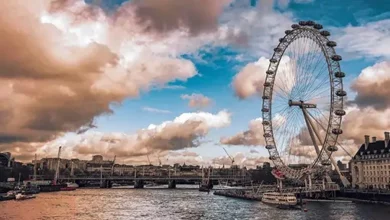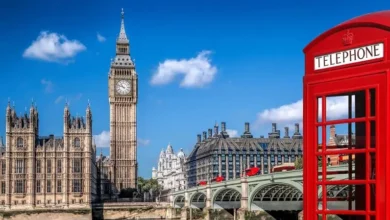The British Museum , a jewel in the heart of London
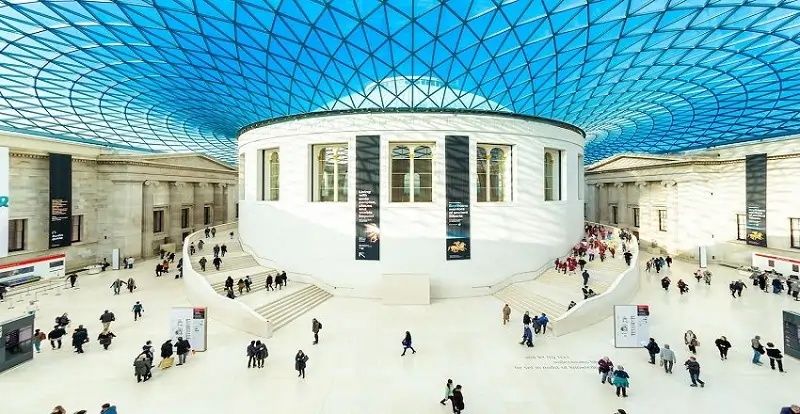
Great Russell Street in the Bloomsbury area of London has been home to the second most visited museum in the world for 260 years. The British Museum is one of the largest and richest museums in the world, with 8 million treasures and permanent artifacts from many cultures and countries. These works have been collected since the beginning of man, about two million years ago.
About 6.5 million people from different countries visit this spectacular museum in England every year. The British Museum has 94 galleries and ten various departments.
In this article from Nabtrip magazine, follow us to learn everything you need to know before going to the British Museum.
Establishment of the British Museum
The British Museum was established in 1753 with the collection donated by Irish physician and scientist Hans Sloan, with the approval of the Parliament of that time. The British Museum is older than the United States.
Sloan’s donated collection includes manuscripts, old books, and antiquities from some British colonies.
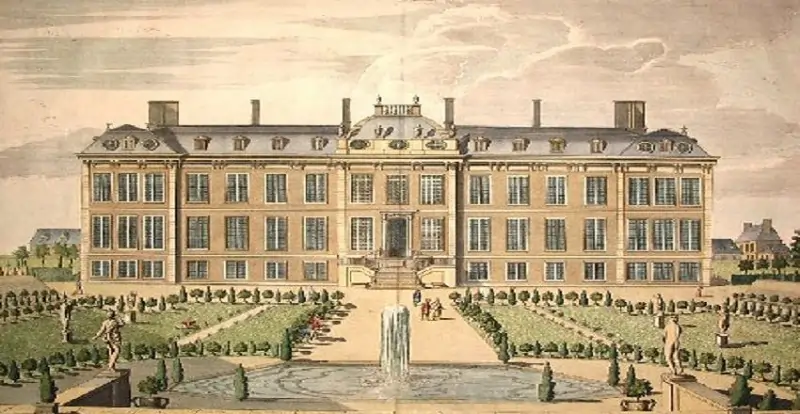
A committee of distinguished trustees founded the museum in a 17th-century mansion called Montagu House, bought with money raised from the public.
It was officially opened to the public in 1759 with new sections. But it is said that there was a need to make a reservation to visit this museum in the first years.
The number of visitors in the early years reached about 12,000 people annually. They visited the British Museum to see antiquities from Aztec Mexico to ancient Egypt to India and Japan, classical sculpture, natural history and geology, manuscripts, maps, coins, and medals.
Museum architecture
At the heart of the museum is a vast quadrangular courtyard, with 43 14m high columns inspired by the Anahita Temple columns, triangular decorations, and grand staircases, certainly not what you’d expect to see in central London.
The British Museum, one of the most attractive places to visit in England, is designed to match the magnificence of the objects inside. “Sir Robert Smirk,” in the design of the British Museum, has imitated the classical architecture of ancient Greece, which was popular in Western Europe in the 18th century.
Different parts of the museum
Over time, various sections were added to the British Museum, resulting from British colonial expansion. One of these sections is the British Museum of Natural History, which was added to the museum in 1881 and is located in South Kensington.
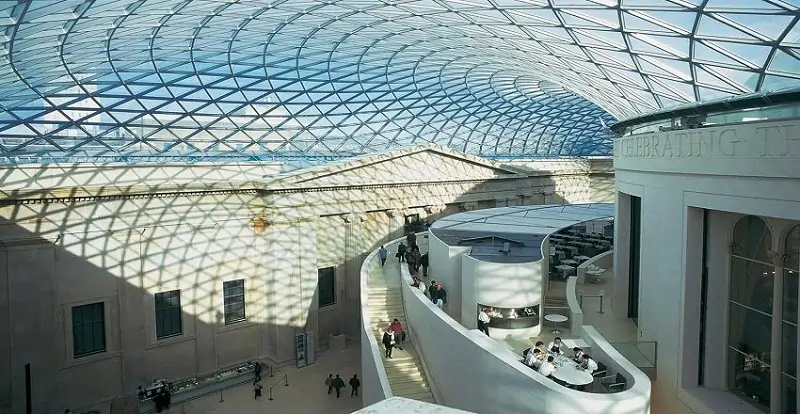
Another section is in St Pancras; The museum library was separated from the museum in 1973. The library contains one of the world’s largest collections of books, manuscripts, and periodicals, both contemporary and ancient, in English and other foreign languages.
It might be called the British Museum, but most objects are on loan from other countries or bought from private collections. You also can’t escape the fact that many things were brought to London with British imperial ingenuity, And many countries want their ancient things back.
The British Museum is divided into sections corresponding to regions and periods. You’ll find separate areas for Ancient Egypt, Ancient Greece and Rome, Asia, Europe, the Middle East, and the Americas spread over three floors.
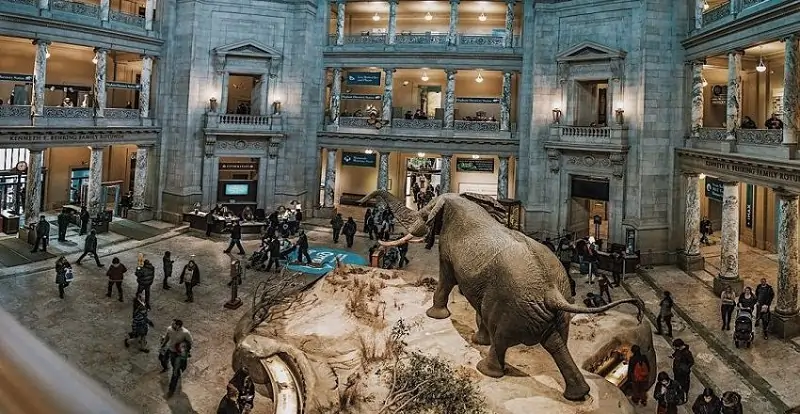
The most important departments of the British Museum
In the following, we introduce the essential parts of the British Museum.
British Museum Library
Upon entering the library, its unique and circular architecture will attract your attention. All the books and the reading room are circular, and the beauty of this library has doubled. The architect of this domed library is Sidney Smirk. The construction of the library began in 1854 and was completed in 1857.
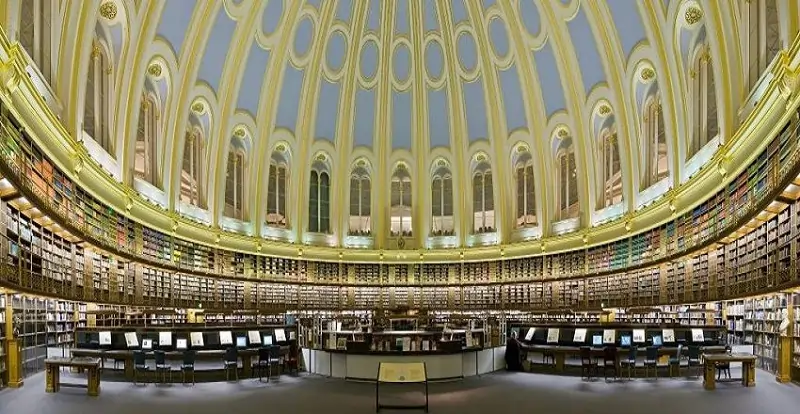
The British Museum library was a part of the museum until 1973. This year, the National Library of Oman, the Central National Library, and the British National Bibliography Organization also joined this library. They became one of the richest libraries in the world with fifteen million volumes of books.
Works in most languages of the world are kept in the different collections of this library. There are books in more than three hundred and fifty languages of the world only in the eastern collections of the library.
This library hosts a rich collection of Iranian art with 404 collections of paintings by Iranian artists whose list was compiled in 1977, along with ancient Persian manuscripts.
Currently, only the manuscript section is housed here, and the rest of the books have been moved to the new library at St Pancras.
If you are interested in collecting stamps, The stamp section of the museum library can surprise you. Arabic manuscripts, oriental books, the library collection of the Diwan of India, maps, and musical works are other parts of the British Museum library.
Ancient Egypt and Sudan section
The British Museum houses the largest and most complete collection of Egyptian antiquities outside Egypt, with more than a hundred thousand works.
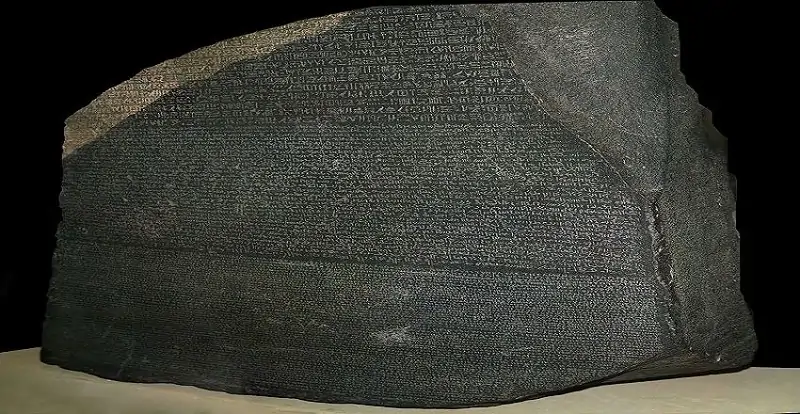
At the time of the museum’s establishment, Hans Sloan donated 160 ancient objects from Egypt to this museum. After the French forces’ defeat under Napoleon’s command in the Battle of the Nile in 1801, the Egyptian antiquities collected by the British army were confiscated and presented to the British Museum in 1803.
Excavations in Egypt continued until the 20th century but were stopped when the law changed. Of course, excavations continue in several sites in Sudan.
The Rosetta Stone (Rashid) and the mummies of the Egyptian royal family are among the most important works related to ancient Egypt in the British Museum.
In the gallery on the second floor of this museum, you can see 140 mummies, which will give you a pure experience.
Ancient Greek and Roman section
The British Museum has one of the world’s largest and most comprehensive collections of classical artifacts, with more the, an 100,000 works.
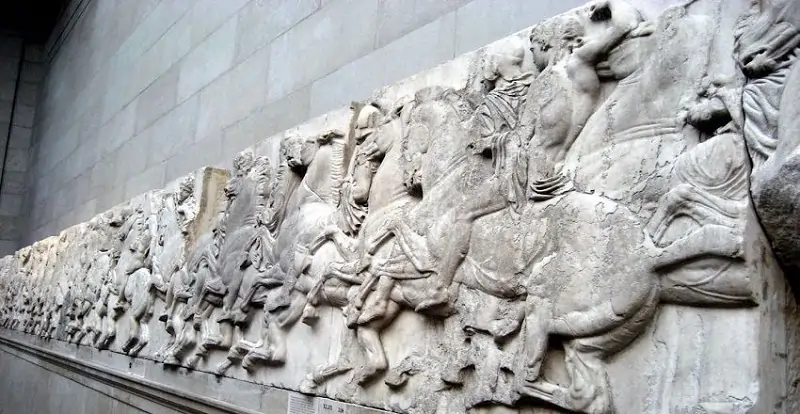
These works are mainly collected from the beginning of the Bronze Age of Greece (about 3200 years BC) until the establishment of Christianity as the Roman Empire’s official religion under the reign of Roman Emperor Constantine I in 313 AD.
While visiting the Ancient Greek and Roman section of the British Museum, In room 18, you will see the collection of Elgin marbles, which were once part of the 2,500-year-old Parthenon temple. This work is related to 447 BC.
In room 17, the Nerid monument’s restoration dates back to 390 BC and is impressive.
Artifacts from the Halicarnassus tomb, from 353 to 350 BC, One of the seven wonders of the ancient world, can be seen in room 21 of Greece and Rome.
The British Museum also has 17 statues and 15 stone tablets out of the 92 tablets of the Paralisos temple.
Printing and painting department
From the paintings of Leonardo da Vinci to Raphael, from the art of Pablo Picasso to the miracles of Michelangelo, Everyone has settled in Room 90 in the Prints and Paintings Department of the British Museum.
Printing and painting group; It has a national collection of Western prints and paintings. There are more than 50 thousand paintings and two million photographs. The collection of images from the 14th century to the present is one of the quality works of prominent European artists.
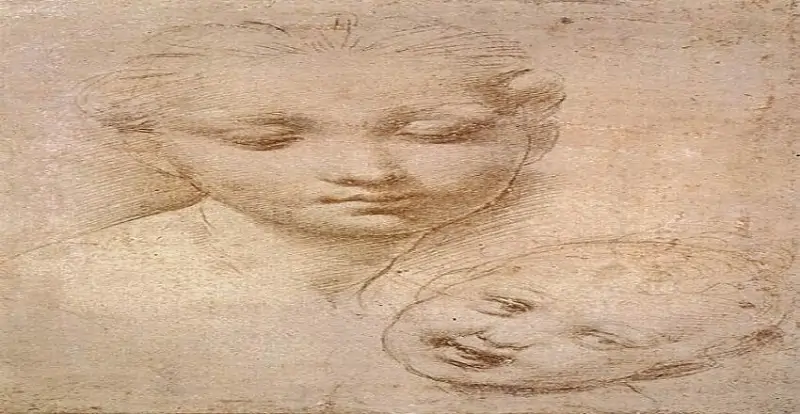
It also covers printed works from early prints in the 15th century to the present day.
British, European, and Prehistoric Section
Step into the Britain, Europe, and Prehistory section, and see a vast expanse of time and geography.
This section includes some of the earliest objects made by humans in East Africa from more than 2 million years ago, prehistoric and Neolithic objects from other parts of the world, and European art and archeology from the earliest times to the present day.
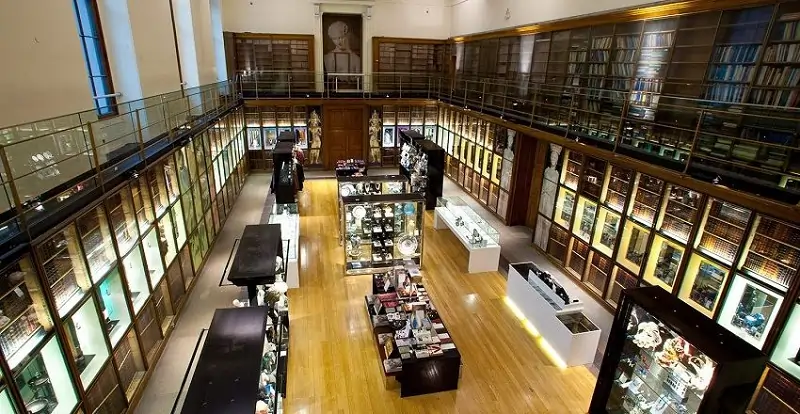
In this section, artifacts and objects from the Stone Age (about 3.4 million years BC to 2000 BC), the Bronze Age (3300 to 600 BC), the Iron Age (about 600 BC to Century 1 AD), Romano-Britain (43 AD – 410 AD), Early Middle Ages (4th century AD to c. 1000 AD), Middle Ages (c. 1000 AD to c. 1500 AD) and Renaissance to Modern (c. 1500 AD to present day) ) Collected.
You will see much history in this part of the British Museum. The charm of the British, European, and prehistoric sections is indescribable.
Asia section
The Middle East section is separate from the Asian area of the British Museum due to its importance and rich historical background. In this section, 75,000 works are from East, Southeast, and Central Asia. These works reflect the diverse culture of the world’s largest continent, from China and Japan to India.
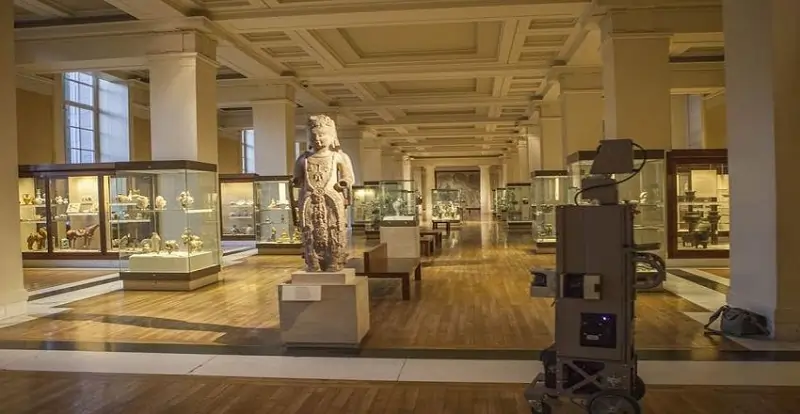
One of the reasons why the British Museum is unique is the extent of its colonization. For example, most of the works in the Asian section of the museum; It is related to India, which was a British colony for many years.
Africa, Oceania, and the Americas section
The British Museum houses one of the most comprehensive collections of ethnography in the world from Africa, Oceania, and the American continent, representing the culture of indigenous peoples worldwide.
More than 350,000 objects narrate the diverse and rich culture of these three continents over a thousand years.
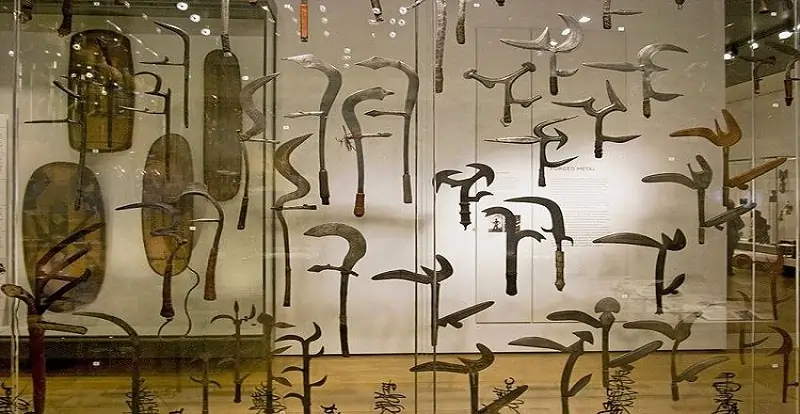
Room 24 in this section showcases ethnography from all continents, and if you go down one floor, you’ll find Room 25, which focuses on African art.
Plans are underway to develop permanent galleries to showcase Oceania and South American art.
Coins and medals section
If, like me, you are interested in seeing old coins and bills; The good news is that the British Museum has one of the best numismatic collections in the world, which includes about one million objects, including coins, medals, badges, and paper money.
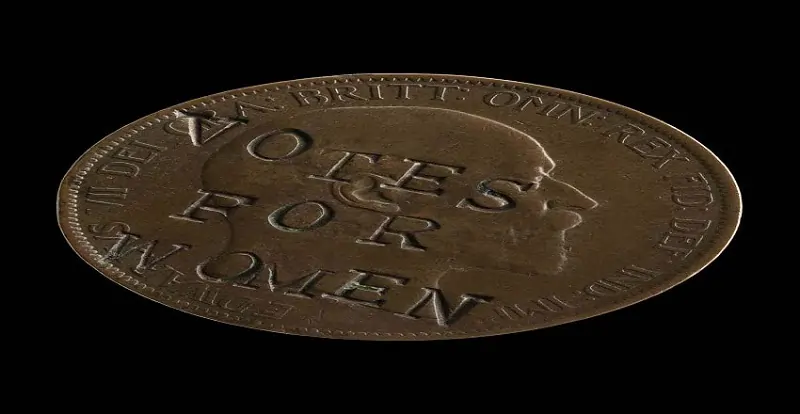
This collection contains the entire history of the coin from its origins in the 7th century BC to the present day and represents both East and West. The Coins and Medals Department was established in 1861 and celebrated its 150th anniversary in 2011.
Department of Protection and Maintenance and scientific research
This department was established in 1920. The protection and maintenance department has six specialized departments: ceramics and glass; Metals; organic materials (including fabrics); stone, wall painting, and mosaic; and Eastern and Western painting art.
The scientific research department has also used new methods to obtain ancient artifacts and analyze and identify the materials used in their construction. The British Museum is still involved in many ancient discoveries.
The cost of visiting the British Museum
It’s free! Yes, you read that right. There is no entrance fee or ticket to visit most parts of the British Museum. But some special exhibitions and works that do not belong to the museum itself; include costs.
The most famous works of the British Museum
If you don’t have enough time to visit the museum and don’t want to wander between different sections, don’t worry.
Start your visit with these collections:
Egyptian galleries, room 4
This spectacular gallery on the museum’s west side houses sculptures and artifacts from about 3000 years of Egyptian civilization.
The most famous work of the British Museum, the Rosetta Stone, dating back to 196 BC, is located in this part of the museum. Other works in Egyptian galleries include spectacular sculptures, carved sarcophagi, and a bust of Ramesses II, the most powerful pharaoh in Egyptian history.
Parthenon statues, room 18
These beautiful walls and sculptures form part of the Parthenon in the Acropolis of Athens, built between 447 and 438 BC.
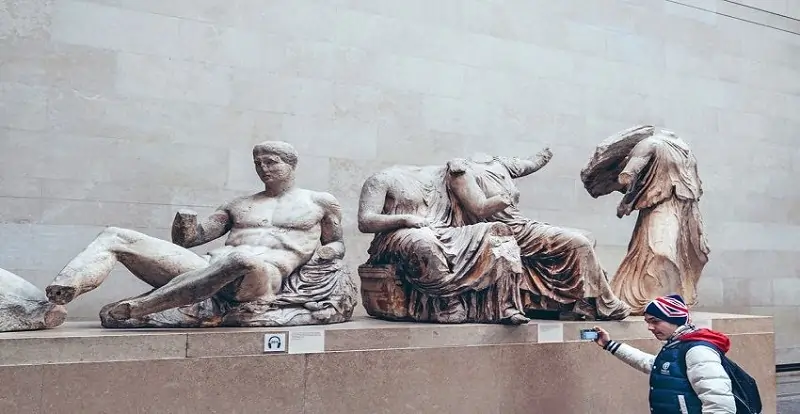
They were brought to London in 1805 by Lord Elgin, the British ambassador to the Ottoman Empire, to save them from further destruction and wear and tear.
Porcelain Collection (Sir Percival David Collection), Room 95
This unique porcelain, ceramics, and rare earthenware collection is highly valued for its beauty and rarity. Some pieces are related to the invention of porcelain around 2000 years ago.
The most critical work of this section is two white and blue Chinese vases known as “David vases.”
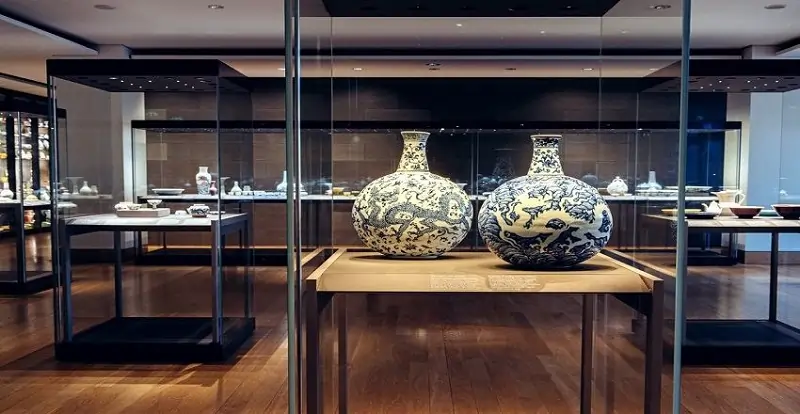
Sutton Ho parts, room 41
The discovery of an Anglo-Saxon ship in 1937, dating back to 600 BC, was an astonishing discovery of royal treasures. The 88.5-foot-long ship was an archeological dream, filled with treasures, including gold jewelry, Byzantine silverware, a magnificent coffin, and its helmet.
Sutton Ho’s hat is one of the four remaining hats from that era, made of iron and copper.
Now in the 21st century, you can see these works up close.
Assyrian lion hunting, room 10
The marble reliefs in this gallery depict the hunting rituals of Assyria’s last great king, Ashurbanipal, who lived between 668 and about 630 BC.
The figures show a complete story, from freeing the lions to their subsequent pursuit and killing them with bows and arrows, a sign of the king’s power.
Cyrus cylinder or Cyrus prism, room 52
A baked clay tablet was written in 538 BC by Cyrus, the Achaemenid king.
Parts of another version of the cylinder’s text have recently been identified on two clay tablets in the Babylonian collection of the British Museum, which is the survivor of the archived version of this cylinder.
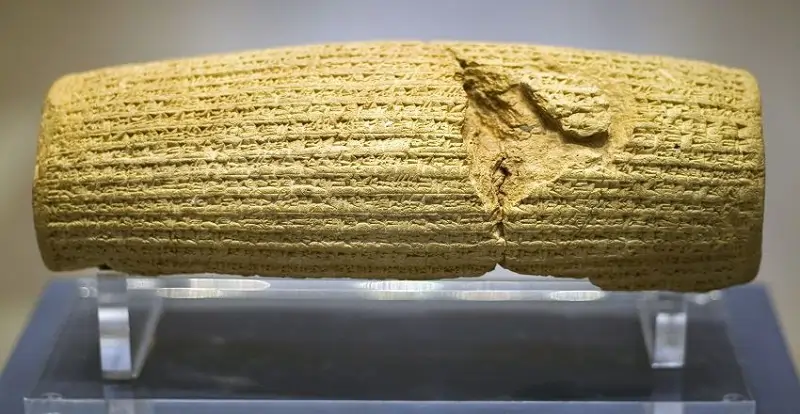
This cylinder was found in the year 1258 AD (1879 AD) in the temple of Esgileh (temple of Marduk, the great Babylonian god) in the ancient city of Babylon and is kept in the British Museum.
This document is known by many as the first charter of human rights. In 1971, the United Nations published it in the organization’s six official languages. Instead of this charter, it is kept at the United Nations headquarters in New York City.
Four horse golden chariot, room 52
The four-horse golden chariot is an ancient artifact of the Achaemenid period found in Amu Darya’s treasure.
This chariot belongs to 300 to 500 years BC. This work is a four-horse chariot with two people wearing Achaemenid clothes riding on it.
Goat and Homa bird gold bracelet, room 52
Another of the hundreds of pieces discovered in the Amu Darya treasure is the gold bracelet of the Goat and the Huma bird.
This armband is decorated with a mythological animal, which consists of the horns and body of a goat and the face and wings of the mythical Huma bird, and are symmetrically placed on top of each other.
This bracelet belongs from 500 years BC.

